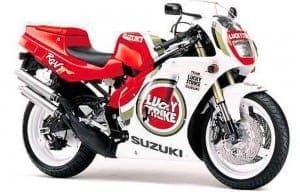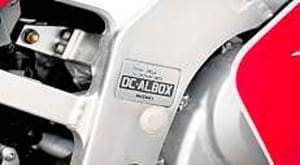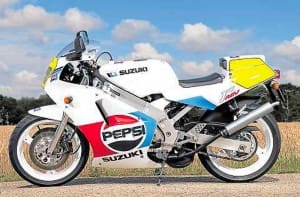Bursting with technology and GP heritage, the RGV250 is still a bargain stink wheel
 American critic and commentator Alexander Woolcott once stated: “All the things I really like to do are either immoral, illegal, or fattening”. Had he lived until the introduction of Suzuki’s sublime RGV250 he’d have found the bike ticked at least two criteria on his list.
American critic and commentator Alexander Woolcott once stated: “All the things I really like to do are either immoral, illegal, or fattening”. Had he lived until the introduction of Suzuki’s sublime RGV250 he’d have found the bike ticked at least two criteria on his list.
In a world obsessed with moral green issues a two-stroke motorcycle is (in the eyes of some) Beelzebub personified; factor in the RGV’s race inspired tendencies and it’s easily possible to be reprehensibly law breaking on one as well. Of course, none of this really matters when you own what many consider to be the apogee of Japanese two strokes.
 But how good is an RGV250? Officially arriving in Europe in 1989, a few RGVs found their way here earlier and a first-off model made its way to Crooks Suzuki in Barrow-in-Furness. Boss Martin Crooks had sufficient faith to run the bike in two Manx GPs (’88 and ’89) with an absolute minimum of tweaking. By way of rewarding the rider’s unswerving loyalty to the brand the RGV250 turned in two places towards the top 20 finishers: not enough to earn Martin a replica but more than enough to show what could be done with what amounted to a fairly factory standard production bike.
But how good is an RGV250? Officially arriving in Europe in 1989, a few RGVs found their way here earlier and a first-off model made its way to Crooks Suzuki in Barrow-in-Furness. Boss Martin Crooks had sufficient faith to run the bike in two Manx GPs (’88 and ’89) with an absolute minimum of tweaking. By way of rewarding the rider’s unswerving loyalty to the brand the RGV250 turned in two places towards the top 20 finishers: not enough to earn Martin a replica but more than enough to show what could be done with what amounted to a fairly factory standard production bike.
That’s not a bad start to a model run that officially lasted from1988 through to 1994 in the UK and ultimately went on to power Aprilia’s RS250 in modified form right into the new millennium.
 The RGV’s power to weight ratio along with that alloy frame, super crisp V-twin motor plus excellent cornering capabilities all combine to deliver thrills out of all proportion to their worth or value. The RGV250 clearly demonstrates that ultimate horsepower isn’t the only factor that governs a machine’s desirability or potential kudos; in bikes such as this there’s an indefinable something that means you don’t need hairy chested, testosterone fuelled machismo to enjoy a bike to its full potential. A properly set up and ridden RGV250 has giant-killing potential while keeping a grip on reality both in terms of financial outlay and outright speed.
The RGV’s power to weight ratio along with that alloy frame, super crisp V-twin motor plus excellent cornering capabilities all combine to deliver thrills out of all proportion to their worth or value. The RGV250 clearly demonstrates that ultimate horsepower isn’t the only factor that governs a machine’s desirability or potential kudos; in bikes such as this there’s an indefinable something that means you don’t need hairy chested, testosterone fuelled machismo to enjoy a bike to its full potential. A properly set up and ridden RGV250 has giant-killing potential while keeping a grip on reality both in terms of financial outlay and outright speed.
It doesn’t seem to matter who you talk to among RGV owners, they all have tales of riding the wheels off their machines, and whether it’s an older model with conventional forks or a later version sporting USDs, the stories are all uncannily similar. When you know that the RGV’s chassis can happily contain a tuned RG500 lump, you kinda’ pick up this is one very serious pint-sized race rep with true GP heritage currently available at bargain prices.
 What to buy and how much to pay
What to buy and how much to pay
Although it’s hard to believe given how good these bikes are, they can turn up for less than £700: if it’s all there, grab it. Private sales for good, viable bikes will start around £1250- £1500 and move up from there. Dealer prices for later examples hover in the £1800-£2600 area with the occasional late, mint, ultra-low, mileage example up at around £3500. If you’re buying a non-UK example check out if it’s restricted to 45bhp. Such heinous hobbling can be overcome but take expert advice before committing cash.
Forget R1s, shunZX whatevers, ignore CBR hypersports and turn a blind eye even to the Gixxer; grab an RGV250 before the suits ban them or the prices rise, as they surely will. The humble stink-wheels really don’t get much better than this.
Suzuki RGV250
1987 VJ21 H blue/white
 1988 VJ21 J blue/black/white + SP version
1988 VJ21 J blue/black/white + SP version
1989 VJ21 K blue/black/white, black with red panels or Pepsi scheme. Officially imported into the UK
1990 VJ21 L blue/white, red/white and black/silver. Fully adjustable suspension, bigger 34mm carbs
1991 VJ22 M USD forks, 17in rear wheel, banana swingarm
1992 VJ22 N Shorter seat unit
1993 VJ22P Braced item replaces banana swingarm
1994 VJ22 R Revised power valves. Blue/white or black
1995 VJ22 S blue/white or black/purple
1996 VJ22 T red/white Lucky Strike scheme or black/dark blue/white
1997 VJ23 U Cylinders move from 90º to 70º. SP version in black/white/red
EXHAUST Many will be running aftermarket systems. Ask around as to the provenance of any fitted to your candidate bike. Performance twostrokes are fickle beasts when it comes to pipes and cans.
ENGINE Power valves are poorly lubricated and can die – they are often seen as the weak link on RGV250s in terms of long-term reliability. Being a two-stroke, rings, pistons and little ends can also lead a hard life. Top two-stroke tuner Stan Stephens says: “The RGV250 M/N/P/R models suffer from horrendous PV problems, there are so many moving parts and none of it is lubricated. The PV is made in three parts with a small roll-pin held in the centre part (the blade), which slides up and down in slots in the other two parts. Unfortunately, the pin comes loose, allowing the centre blade to drop down into the engine.” The good news is that there are several aftermarket valve replacement options that don’t have these issues.
CHASSIS Many RGVs have been used as track bikes so check for crash damage. However, the alloy frame is quite a robust piece of kit.
PLASTICS Pattern fairings aren’t uncommon: look for signs of bad repairs and scuffed footrests.
SUSPENSION Other than being a little soft, very good but can be improved via specialists such as Maxton, Nitron or K-Tech.
BRAKES Other than normal servicing needs, they are top-notch devices. Braided hoses will improve feel.
 Suzuki RGV250 (based on VJ21 K spec)
Suzuki RGV250 (based on VJ21 K spec)
Price: £700-3500
Engine: 249cc six-speed, liquid-cooled 90º Vtwin, two-stroke 2x Mikuni 32 carbs (post ‘90
34mm)
Power (claimed): 58bhp@11,000rpm
Torque (claimed): 28.93 lb-ft@11,000rpm
Bore x stroke: 56 x 50.6mm
Rake and Trail: 64º/98mm
Chassis: Alloy beam
Wheels/tyres: Front: 110/17 x 17in Rear: 140/60 x 17in (150/60 post ‘90)
Suspension: Front: Telescopic fork, coil spring, oil damped, spring 5-way adjustable,120mm wheel travel. (41mm USD post ‘90). Rear: Full floating system, gas/coil spring, oil damped, spring 7-way adjustable,140mm wheel travel
Brakes: Front: 2x 300mm disc, four-piston calipers. Rear:210mm disc twin piston caliper
Wheelbase: 1375mm
Seat height: 755mm (766mm post ‘90)
Dryweight (claimed): 128kg (139kg post ’90)
Fuel capacity: 17 litres (16 litres post ’90)





